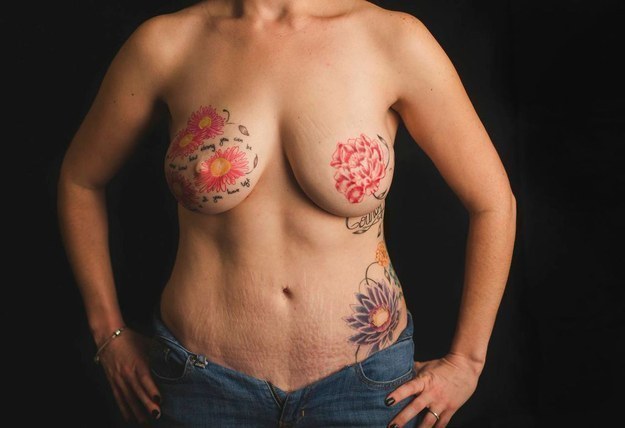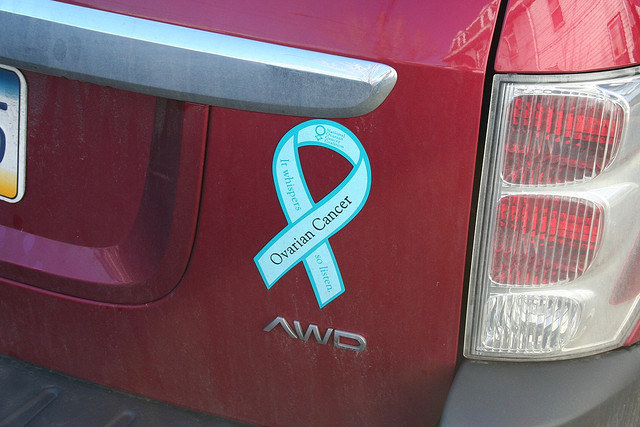Angelina Jolie wrote in the New York Times that she chose to have her ovaries and fallopian tubes removed as a preventative measure to lower her risk of ovarian cancer.

Here are some things you should know about BRCA genes, cancer, and preventative surgery.
BuzzFeed Life talked to Karen Lu, M.D., professor of Gynecologic Oncology, co-director for Clinical Cancer Genetics, and director of the High Risk Ovarian Cancer Screening Clinic at The University of Texas MD Anderson Cancer Center, for some answers and clarity.
1. BRCA1 and BRCA2 are genes that can have mutations that greatly increase your risk of getting breast cancer and ovarian cancer.
Roughly 12% of women will develop breast cancer in their lives, according to the National Cancer Institute. But for women who carry the BRCA1 genetic mutation, that number goes up to 55–65% by the age of 70; for BRCA2, the risk is around 45%.
With ovarian cancer, an average of about 1.4% of women in the general population will develop ovarian cancer in their lifetime. But with BRCA1 that number goes up to 39%, and BRCA2 it's somewhere between 11 and 17%. (There are varying reports of exact percentage increase, depending on the source, but the general consensus is that the risk with BRCA genetic mutations is much higher than without.)
Jolie is a BRCA1 carrier.
2. The BRCA genetic mutations are pretty rare.
In the general population, it's estimated that about 0.2 to 0.3% of women are BRCA genetic mutation carriers (between 1 in 300 and 1 in 500 women). For women of Ashkenazi Jewish descent, that percentage goes up to roughly 2.1% (about 1 in 47 people).
3. Because the genetic mutations are so rare, doctors recommend that people only get tested for them if they have certain family history indicators.
"Family history has really been the cornerstone of genetic testing," Lu says. Here's what might make you a good candidate for genetic testing for the BRCA1 or BRCA2 mutations, according to the National Cancer Institute:
— If a family member on either your mom or your dad's side has been diagnosed with breast cancer before age 50
— If a family members has been diagnosed with ovarian, fallopian tube, or peritoneal cancer
— If a family members has had cancer in both breasts
— If you have a family history of both breast cancer and ovarian cancer (meaning one person had breast cancer and another had ovarian cancer)
— If a family member has had multiple instances of breast cancer
— If a family member has had 2 primary types of BRCA-related cancer
— If a family member has had male breast cancer
— If you have Ashkenazi Jewish ethnicity
If any of these markers apply to you, you should absolutely talk to your doctor about your risks, and whether genetic testing is right for you. In fact, if you have any family members who have had cancer, you should share that information with your doctor, Lu says. Depending on your family size, the number of women in your family, your personal health behaviors, and other factors, you may be a candidate for genetic testing, even if you don't necessarily match the requirements listed above.

4. There's no effective way to screen for ovarian cancer.
Screening mammograms can help patients and doctors detect breast cancer at early stages of development, when they're easier to treat. But there isn't an equivalent test for ovarian cancer. "By the time someone has symptoms [of ovarian cancer], they typically have a very advanced disease," Lu says. "It's a deadly cancer, and we have no effective screening."
For high-risk patients (patients with the BRCA1 or BRCA2 genetic mutations), Lu says that many doctors will recommend ultrasound and a CA-125 blood test every six months. "But as a physician I always say that I don't want the patient to be false reassured," she says. Those tests can have a high false-negative rate.
5. Because there's no effective way to screen for ovarian cancer, if you carry the BRCA1 or BRCA2 mutations, the recommendation is that you have your ovaries and fallopian tubes removed.
This is what Angelina Jolie chose to do. "From a doctor's standpoint, the recommendation for removing the ovaries and fallopian tubes is pretty straightforward," Lu says. Here's why: There's no way to screen for ovarian cancer. The lifetime risk for the deadly cancer is incredibly high in BRCA genetic mutation carriers. And preventative removal of the ovaries and fallopian tubes for BRCA mutation carriers has been shown to save lives.
Removal of your ovaries and fallopian tubes, if you have BRCA1 or BRCA2 mutations, has been associated with a 77% reduction in your overall risk of death by the age of 70, according to the American Society of Clinical Oncology. It reduces your risk of ovarian cancer by 80%, and reduces your risk of breast cancer by 48%.
6. A preventative double mastectomy can also significantly reduce your risk of cancer, but it's a less straightforward decision.
"From a doctor's standpoint, the recommendation for removing the ovaries and fallopian tube — preventive surgery to prevent ovarian cancer [if you carry the BRCA1 or BRCA2 genetic mutations] — is actually more straightforward than the decision for bilateral [prophylactic] mastectomy [for BRCA genetic mutation carriers,]" Lu says. "The reason is there is no effective screening for ovarian cancer, whereas there is screening for breast cancer."
According to the National Cancer Institute, bilateral prophylactic mastectomy can reduce the risk of breast cancer in BRCA1 or BRCA2 mutation carriers by 95%, and can reduce the risk of breast cancer by 90% for women with a strong family history.
Choosing to undergo a preventative double mastectomy is an incredibly complicated, personal, and difficult decision. If you have either or both of the BRCA mutations, or a strong family history of breast cancer, you should discuss your options and risks with your doctor, and seek multiple opinions from a variety of experts. Angelina Jolie weighed her risks and options, and decided two years ago that a double mastectomy was the right choice for her.

7. If you carry the BRCA1 genetic mutation, doctors recommend the preventative surgery to remove your ovaries and fallopian tubes around age 35 to 40. If you are a BRCA2 carrier, the recommendation is to have the surgery in your early 40s.
Jolie is 39, and has the BRCA1 mutation. She also has a family history of ovarian cancer, where her mother was diagnosed at age 49. Lu says that is another general rule of thumb: preventative surgery 10 years before the age at which your family member was diagnosed with the disease.
8. Removing your ovaries and fallopian tubes means you enter menopause, and can no longer get pregnant.
Entering menopause "early" can be an enormously complicated and emotional decision. For women who haven't yet had children (or who want to have more children), the decision can be even more fraught.
The rise of genetic testing due to family history has brought these difficult issues to the forefront in ways they hadn't been discussed previously. "15 years ago when I was seeing [BRCA genetic mutation carrying] patients, the vast majority of patients who had the testing already had breast cancer," Lu says. "When they were thinking of their ovarian cancer risk, it was a clear decision to have the surgery." Chemotherapy can often trigger menopause, so for women who were already effectively menopausal due to their breast cancer treatments, it wasn't quite as complicated a choice to also remove their ovaries and fallopian tubes. "Now we're seeing a whole generation of women who never had cancer before, but who have high risk, and the choices they make are different than someone who's had cancer in the past," Lu says.

9. The recommendation to remove your ovaries and fallopian tubes ONLY applies if you have the BRCA1 or BRCA2 genetic mutations.
"The most important thing is that you need to figure out what your risk is for ovarian cancer, and then you figure out what you do about it," Lu says. "I don't want people who just have a family history to say, I want my ovaries out [after reading about Angelina Jolie's decision]." Jolie has the BRCA1 mutation, as well as three family members who have died from related cancers. Her choice is incredibly specific to her circumstances — your personal decisions, history, and risk levels may not be the same as hers.
For instance, if you have a family history of ovarian cancer, and test negative for both of the BRCA genetic mutations, the decision becomes less clear. "We don't know what your risk is — it could be 1%, or up to 50%," Lu says. "That's where you have to really think about it, and talk to your doctor about the risks and benefits, and really customize a preventative strategy."
10. Taking the birth control pill can decrease your risk of ovarian cancer.
So let's say you have a family history of ovarian cancer, but aren't a carrier of the BRCA1 or BRCA2 genetic mutations. One preventative step you might consider would be to take the birth control pill. A review of 45 studies published in The Lancet found that the longer a woman took hormonal birth control, the lower her risk of ovarian cancer was.
That being said, there's some evidence that birth control is linked to a slightly increased risk of cervical and breast cancer, as well as an increased risk of blood clots. So as with all medical decisions like this, it's very important to talk about your personal and family history with your doctor, to determine the best decision for you.

For more information about BRCA genetic mutations, breast cancer, and ovarian cancer, check out these fact sheets and tools from the National Cancer Institute:
BRCA1 and BRCA2: Cancer Risk and Genetic Testing
Breast Cancer Risk Assessment Tool
The information in this story is by no means comprehensive. So definitely continue reading, and ask your doctor if you have any questions at all.
BRCA1 and BRCA2 genetic mutations can increase your risk of breast cancer and ovarian cancer. An earlier version of this post misstated that the BRCA1 and BRCA2 genes could increase your risk of breast cancer and ovarian cancer.
